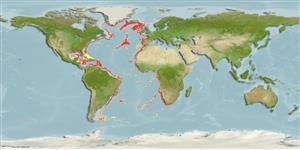>
Ophidiiformes (Cusk eels) >
Ophidiidae (Cusk-eels) > Neobythitinae
Etymology: Dicrolene: Greek, dikros = with two ends + Greek, lenos , ou = cavity in the skull (Ref. 45335).
More on authors: Goode & Bean.
Environment: milieu / climate zone / depth range / distribution range
Écologie
marin bathydémersal; profondeur 700 - 1785 m (Ref. 34024), usually 1000 - 1600 m (Ref. 33456). Deep-water
Eastern Atlantic: continental slope all along West Africa. Western Atlantic: warmer parts of the area including the Gulf of Mexico.
Taille / Poids / Âge
Maturity: Lm ? range ? - ? cm
Max length : 35.0 cm TL mâle / non sexé; (Ref. 27000)
Épines dorsales (Total) : 0; Rayons mous dorsaux (Total) : 100 - 115; Épines anales: 0; Rayons mous anaux: 85 - 98. Snout rather blunt; eye diameter almost as long as snout; opercular spine strong and straight; hind margin of preopercle usually with 3 sharp spines; 1 median (broad) and a pair of basibranchial tooth patches; pseudobranchial filaments 2 or 3; 7-15 developed rakers on anterior arch; lower 5-11 pectoral fin rays free and longer than upper ones; precaudal vertebrae 13-16 (Ref. 34024). No black fin rays; one supraorbital and 3 preopercular spines all strong (Ref. 34024).
Common species (Ref. 34024). Oviparous, with oval pelagic eggs floating in a gelatinous mass (Ref. 205).
Life cycle and mating behavior
Maturité | Reproduction | Frai | Œufs | Fécondité | Larves
Nielsen, J.G., D.M. Cohen, D.F. Markle and C.R. Robins, 1999. Ophidiiform fishes of the world (Order Ophidiiformes). An annotated and illustrated catalogue of pearlfishes, cusk-eels, brotulas and other ophidiiform fishes known to date. FAO Fish. Synop. 125(18):178p. Rome: FAO. (Ref. 34024)
Statut dans la liste rouge de l'IUCN (Ref. 130435: Version 2024-2)
Menace pour l'homme
Harmless
Utilisations par l'homme
Outils
Articles particuliers
Télécharger en XML
Sources Internet
Estimates based on models
Preferred temperature (Ref.
123201): 3.2 - 7, mean 4.3 °C (based on 608 cells).
Phylogenetic diversity index (Ref.
82804): PD
50 = 0.5000 [Uniqueness, from 0.5 = low to 2.0 = high].
Bayesian length-weight: a=0.00110 (0.00040 - 0.00297), b=3.08 (2.85 - 3.31), in cm total length, based on LWR estimates for this (Sub)family-body shape (Ref.
93245).
Niveau trophique (Ref.
69278): 3.0 ±0.18 se; based on food items.
Résilience (Ref.
120179): Milieu, temps minimum de doublement de population : 1,4 à 4,4 années (Preliminary K or Fecundity.).
Fishing Vulnerability (Ref.
59153): Low vulnerability (25 of 100).
